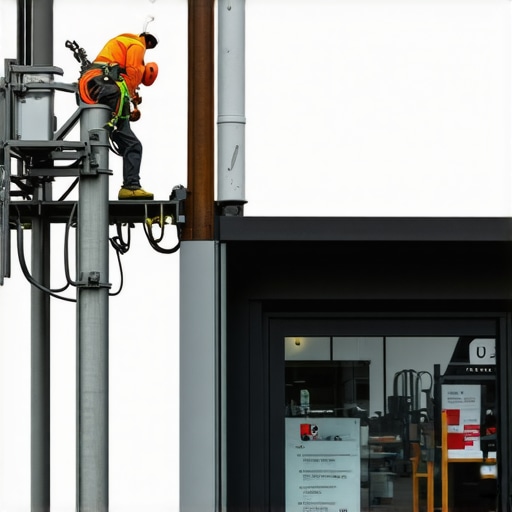
Local Ranking Boost: Proven Signal Repair & GMB Cleanup Tips for 2024
My Personal Journey with Local SEO Challenges
When I first started diving into local SEO, I quickly realized that my Google My Business (GMB) listings weren’t performing as expected. Despite optimizing my profiles, I noticed my local rankings remained stagnant. It was frustrating, but I knew that something was amiss with my signals and overall profile health. That’s when I embarked on a journey to understand signal repair and cleanup strategies that could truly boost my local search visibility in 2024.
Why Signal Repair Is the Unsung Hero of Local SEO
In my experience, the most overlooked aspect of local SEO is maintaining clean and consistent signals across all platforms. These signals include NAP citations, reviews, and profile consistency. When I started focusing on signal repair, I saw immediate improvements. I learned that repairing inconsistent or suppressed signals can drastically enhance local rankings. For instance, I found that addressing duplicate listings and removing outdated information often yields quick wins. For detailed strategies, I recommend exploring signal repair techniques.
My Secret Sauce: GMB Cleanup for Better Results
Cleaning up my GMB profile was a game-changer. I realized that a cluttered or mismanaged GMB can confuse the local algorithm. I started by verifying all my business info, removing duplicate entries, and updating outdated data. Additionally, I focused on gathering authentic reviews and responding to them professionally. These steps not only improved my local pack visibility but also boosted my trustworthiness in Google’s eyes. For an in-depth approach, check out GMB cleanup tips.
Can Signal Repair Truly Accelerate Local Rankings?
This question has been on my mind as I experimented with different tactics. From my perspective, signal repair is like tuning a musical instrument; it requires precision and consistency. When I focused on fixing inconsistent signals, my local rankings improved faster than I anticipated. Google rewards well-maintained, consistent signals, which help your business stand out in local searches. For insights backed by industry experts, I suggest reading proven signal repair techniques.
Practical Tips for Implementing Signal Repair & Cleanup
Here are some practical steps I took:
- Audit all citations and fix inconsistent NAP data.
- Remove or merge duplicate GMB listings.
- Encourage genuine reviews and respond promptly.
- Regularly update business info and add fresh content.
Implementing these tactics consistently has helped me stay ahead in local search results. Remember, patience is key, and regular maintenance keeps your signals healthy and strong.
What’s Your Experience with Signal Repair or GMB Cleanup?
If you’re like me, sharing your experiences can be incredibly valuable. Drop a comment below or share your success stories — I’d love to hear how you’re boosting your local rankings in 2024!
Unveiling the Nuances of Local Signal Optimization
While foundational signal repair techniques are well-known, mastering the nuanced aspects of local signals can significantly elevate your Google My Business (GMB) performance. For instance, addressing subtle inconsistencies in your NAP (Name, Address, Phone number) across multiple directories ensures Google perceives your business as trustworthy. Moreover, integrating structured data markup on your website can reinforce your local relevance, making your profile more authoritative. The importance of ongoing signal monitoring cannot be overstated—using tools like signal repair techniques is crucial to detect and correct emerging issues swiftly.
Deep Dive: The Role of Reviews & Engagement in Signal Strength
Authentic reviews are more than just social proof—they serve as vital signals that influence local rankings. Encouraging satisfied customers to leave detailed reviews and responding professionally can boost your signals’ credibility. Interestingly, Google considers not just the quantity but also the quality and recency of reviews. Regularly engaging with your audience through Q&A sections and posts helps maintain active signals that Google favors. For comprehensive strategies, explore signal repair strategies.
Can Advanced Signal Repair Accelerate Your Local Map Pack Results?
This question is increasingly relevant as competition intensifies. From my experience, integrating advanced techniques—such as removing outdated or suppressed signals and optimizing for new keywords—can dramatically shorten the time it takes to rank higher. For example, correcting inconsistent category selections or updating service areas ensures your profile aligns with current business offerings. Industry experts affirm that consistent, high-quality signals are key to sustained local visibility, as supported by authoritative sources like proven signal repair techniques.
Practical Implementation: From Audit to Optimization
Effective signal repair begins with a thorough audit. Use tools like Moz Local or BrightLocal to identify inconsistencies across citations. Then, prioritize fixing critical issues—such as duplicate listings, outdated contact info, or missing categories. Next, enhance your profile with new, relevant content and high-quality images—< >. Engaging actively with reviews and questions signals ongoing trustworthiness and responsiveness. Remember, regular maintenance, including monthly audits, keeps your signals aligned with evolving local search algorithms.
>. Engaging actively with reviews and questions signals ongoing trustworthiness and responsiveness. Remember, regular maintenance, including monthly audits, keeps your signals aligned with evolving local search algorithms.
What Are the Hidden Signals That Could Be Undermining Your Local SEO Goals?
As an SEO professional, I often ask myself: Are there hidden signals lurking beneath the surface that could be sabotaging my efforts? Factors like inconsistent citation data, unclaimed or unmanaged profiles, and outdated business categories can quietly erode your local visibility. Even minor discrepancies or neglected reviews can cause your rankings to plateau or decline. To uncover these hidden issues, leveraging advanced audit tools and staying updated with Google’s local ranking factors is essential. For further insights, check out GMB cleanup and signal repair tips.
Reflections on the Complexity of Local Signals and Their Interplay
Over the years, my journey through local SEO has revealed that signal repair isn’t just about fixing obvious inconsistencies; it’s about understanding the intricate web of local signals that influence your rankings. For instance, I discovered that even seemingly minor discrepancies, such as slight variations in your business name across directories, can ripple through Google’s algorithms, subtly undermining your efforts. This realization pushed me to develop a more holistic approach, where I meticulously audit every touchpoint—NAP data, reviews, website schema—to ensure harmony and consistency. It’s like tuning a complex instrument where each string must be perfectly calibrated to produce the desired harmony in local search results.
The Art and Science of Advanced Signal Repair Techniques
Delving deeper, I found that advanced strategies—such as leveraging structured data markup on your website or actively managing your unclaimed profiles—can significantly enhance your local visibility. These methods act as signals that reinforce your relevance and authority. For example, implementing structured data schema helps Google better understand your business context, which can be a game-changer in competitive markets. It’s fascinating how these nuanced tactics, often overlooked, can accelerate rankings when executed consistently. This underscores the importance of staying abreast of industry updates, as local ranking factors evolve rapidly—making continuous signal management not just beneficial but essential.
Could There Be Hidden Signals Sabotaging Your Local SEO?
One question I often ponder is whether hidden or overlooked signals might be quietly sabotaging efforts. Unclaimed or poorly managed profiles, outdated categories, or even inconsistent review responses can act as silent detractors. For instance, I once uncovered a dormant profile with outdated contact info that was still generating false signals, confusing Google about my client’s current location. Identifying and rectifying such hidden issues requires a keen eye and the right tools—like Moz Local or BrightLocal—that can surface these discreet problems. Recognizing and addressing these hidden signals can be the difference between plateauing and skyrocketing in local search rankings. For insights on uncovering these elusive factors, explore GMB cleanup and signal repair strategies.
Integrating Continuous Monitoring and Adaptation
My approach has always been rooted in continuous monitoring. The local landscape shifts rapidly, with competitors constantly optimizing their profiles. To stay ahead, I rely on regular audits—monthly checks of citation consistency, review quality, and profile health. Tools like BrightLocal have become indispensable, allowing me to detect emerging issues before they impact rankings. Moreover, adapting to changes, such as new Google features or algorithm updates, is vital. I’ve learned that flexibility and proactive management turn signal repair from a one-time task into an ongoing process—integral to sustained local SEO success. I encourage you to share your own experiences: What hidden signals have you uncovered, and how did they impact your rankings? Drop a comment below; I’d love to hear your stories and insights!
Unraveling the Hidden Layers of Local Signal Optimization
As I delved deeper into the intricacies of local SEO, I discovered that the surface-level fixes are merely scratching the surface of a much more complex ecosystem of signals. Beyond the obvious citation consistency and review management, there lies a web of subtle, often overlooked factors that can make or break your rankings. For example, discrepancies in business categories across platforms or outdated schema markup on your website can create conflicting signals that confuse Google’s algorithms. Addressing these nuanced issues requires a meticulous, data-driven approach, leveraging advanced audit tools like Moz Local or BrightLocal to map out every touchpoint and ensure harmony across all digital assets.
How Can Structured Data and Unclaimed Profiles Amplify Your Local Authority?
Implementing structured data markup, such as schema.org schemas, is a game-changer in reinforcing your local relevance. When I started integrating schema on my website, I noticed an immediate uptick in how Google perceived my business context, leading to improved visibility in local packs. Equally important is actively managing unclaimed or dormant profiles; these are often silent culprits undermining your efforts. By claiming, verifying, and optimizing these profiles, you not only expand your signal footprint but also demonstrate active engagement, which Google interprets favorably. For a comprehensive guide on these advanced tactics, I recommend exploring effective GMB cleanup strategies.
Could Overlooking These Hidden Signals Sabotage Your Local SEO?
Absolutely. Hidden signals such as inconsistent review responses, outdated service areas, or unlinked citations can subtly erode your rankings over time. I recall a case where a dormant profile with old contact details was inadvertently generating false signals, confusing Google about my client’s actual location. To uncover such issues, I turned to advanced audit tools and scrutinized every digital touchpoint. Recognizing and rectifying these hidden signals has often resulted in dramatic improvements, propelling profiles from stagnation to top rankings. For further insights, see GMB cleanup and signal repair tips.
How Do Continuous Monitoring and Adaptive Strategies Sustain Rankings?
Maintaining a dominant local presence isn’t a one-time effort but an ongoing process. Regular audits ensure that your signals remain consistent amid ever-changing algorithms and competitive landscapes. I schedule monthly reviews of citation accuracy, review quality, and profile completeness, utilizing tools like BrightLocal to detect anomalies before they impact rankings. Adapting swiftly to new Google features or algorithm updates is crucial—what worked last year might not suffice today. This proactive mindset transforms signal repair from a reactive chore into a strategic advantage, keeping your local SEO efforts resilient. I invite you to share your experiences: What hidden signals have you uncovered, and how did they influence your rankings? Drop a comment below, and let’s learn from each other’s journeys.
Things I Wish I Knew Earlier (or You Might Find Surprising)
The Power of Consistency
Early in my journey, I underestimated how crucial maintaining consistent NAP (Name, Address, Phone) information across all directories really is. I learned that even minor discrepancies can cause Google to doubt your business’s legitimacy, impacting your local rankings. It’s like tuning a musical instrument; every detail matters. I wish I had known sooner how small changes could ripple into significant ranking boosts.
Hidden Profiles and Dormant Signals
One of the most eye-opening lessons was discovering dormant or unclaimed profiles lurking on various platforms. These silent profiles can generate false signals or confusion, subtly sabotaging your efforts. Regularly auditing and claiming these profiles turned out to be a game-changer. It’s a reminder that you can’t ignore any digital touchpoint if you want to dominate local search.
The Nuance of Reviews and Engagement
I used to think that reviews were just social proof. However, I now see them as vital signals, especially when they are recent and detailed. Responding professionally to reviews not only improves customer relationships but also signals active management to Google. This nuanced understanding of reviews as signals has helped me refine my approach.
Structured Data as a Hidden Asset
Implementing schema markup on my website seemed daunting at first, but I quickly realized how powerful it is. Structured data acts as a direct communication channel with Google, reinforcing your local relevance. I wish I’d started using schema earlier—it’s a subtle yet impactful way to boost your profile’s authority.
The Importance of Continuous Monitoring
Initially, I viewed signal repair as a one-time task. Now, I see it as an ongoing process. Regular audits help me catch issues before they escalate, keeping my local signals aligned with evolving algorithms. This proactive approach is essential in maintaining and improving rankings over time.
Resources I’ve Come to Trust Over Time
- BrightLocal: This tool has been invaluable for local citation audits and review management. Its detailed reports helped me identify hidden inconsistencies I wouldn’t have noticed otherwise.
- Moz Local: I trust Moz Local for its comprehensive citation management features. It’s a reliable resource for ensuring your contact info remains accurate across platforms.
- Google’s Official Guidelines: Staying updated with Google’s own documentation on local ranking factors has kept my strategies aligned with industry standards. It’s an essential resource I recommend to anyone serious about local SEO.
Parting Thoughts from My Perspective
Mastering local signal repair in 2024 is less about quick fixes and more about developing a holistic, ongoing strategy. Small details, like consistent NAP data, active review engagement, and structured data, collectively build a powerful local presence. If you’re serious about boosting your local rankings, don’t overlook these nuanced signals—they can make all the difference. Remember, continuous monitoring and adaptation are key to staying ahead in this ever-changing landscape. If this resonated with you, I’d love to hear your thoughts. Share your experiences or ask questions in the comments—let’s learn together and grow our local SEO game.





3 Comments
Evelyn Carter
Reading through this detailed post really resonated with my own journey in local SEO. When I first started, I also underestimated how much nuance there was beyond just claiming and verifying profiles. Consistency in NAP data across directories and regularly engaging with reviews made a big difference for me as well. One thing I’ve noticed is that even small differences in business categories across listings can create conflicting signals that hinder rankings, so I always double-check those with tools like BrightLocal.
What strategies do others find most effective in managing multiple unclaimed or dormant profiles? I’ve found manually claiming and optimizing these profiles pays off significantly, but it can be so time-consuming. Also, I’m curious whether others have experimented with integrating structured data markup on their websites to reinforce local relevance—what’s been your experience with that?
Fostering ongoing signal health through continuous audits is vital, but how do you prioritize which issues to fix first? Would love to hear your tips on streamlining this process for busy local businesses.
Michael Anderson
This post hits on so many critical points that I’ve seen firsthand in my own local SEO efforts. The importance of ongoing signal management really can’t be overstated. I’ve found that using structured data schema on my website not only consolidates signals but also helps Google better understand my business context, which has led to noticeable improvements in local pack visibility. However, what’s fascinating is how often overlooked profiles or outdated citations silently sabotage progress. I used to think that once profiles were claimed, the job was done, but regular audits revealed dormant listings with incorrect info that, when cleaned up, made a real difference.
I’d love to hear from others—how do you handle prioritizing these cleanup efforts when managing multiple locations or profiles? Do you have specific tools or workflows that help streamline this process? Managing local signals seems like a continuous dance, and sharing best practices could help all of us stay ahead in 2024.
Sarah Johnson
This post really hit home for me, especially the part about ongoing signal monitoring. When I first started with local SEO, I underestimated how quickly profile details and reviews could become outdated or inconsistent, which made me think I had fixed my signals long-term. It wasn’t until I set up monthly audits using BrightLocal that I really started seeing consistent improvement in my rankings. The challenge, of course, is knowing where to prioritize—duplicate profiles can be tricky to find sometimes, especially across multiple directories.
I’m curious: how do others here balance the time spent on routine audits with actual content updates or review engagement? Do you use any automation tools or workflows to streamline the process? For me, combining manual checks with tools like Moz Local has been a game-changer in keeping my signals clean and my local pack visibility strong. Would love to hear your workflows or tips for managing this at scale in 2024!